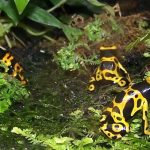How do animals communicate?
The Adams Ant Lab hosted elementary school children from the Junior Explorer Club of Upper Arlington. Recent graduate Mazie Davis and undergraduate students Andrew Mularo and Morgan Oberweiser put together a program to teach the little ones about various ways that animals communicate. First the students played a bioacoustics guessing game – they listened to some diverse audio recordings, courtesy of the Borror Lab of Bioacoustics, and tried to guess what animals they came from.
Can you tell which animals make these sounds? Look for the correct answers at the bottom of this post.
mystery sound 1:
mystery sound 2:
mystery sound 3:
Next the students learned about the use of coloration for communication. They observed camouflage in northern walking stick insects and African ghost mantises, as well as warning coloration in Peruvian black velvet stick insects and yellow banded poison dart frogs.
- Northern walking stick insect
- ghost mantis
- yellow banded poison dart frogs
The last animal communication system we discussed was chemical communication. The students played a game in which they were each given a scented cotton ball (peppermint, almond, vanilla) and were tasked with sorting themselves into groups using only their noses. Then they compared their skills to those of our large Atta ant colony.
The grand finale of the trip was a quick tour of the tetrapod collection lead by Dr. Katherine O’Brien. It was a joy to have such wonderful and inquisitive kids come to visit – we expect to see many of their excited faces return come next spring’s Open House (April 7, 2018)!
About the Author: Morgan Oberweiser is an undergraduate (Evolution and Ecology major) research assistant in Rachelle Adams‘ lab.
Answers to animal sound quiz: sound 1 = American alligator (chickadees scolding the alligator), sound 2 = Texas leafcutting ant, sound 3 = South American catfish





